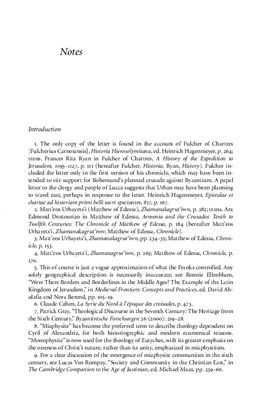University of Pennsylvania Press, 2009, 272 pages
In the wake of Jerusalem's fall in 1099, the crusading armies of weste Christians known as the Franks found themselves goveing not only Muslims and Jews but also local Christians, whose culture and traditions were a world apart from their own. The crusader-occupied swaths of Syria and Palestine were home to many separate Christian communities: Greek and Syrian Orthodox, Armenians, and other sects with sharp doctrinal differences. How did these disparate groups live together under Frankish rule?
In The Crusades and the Christian World of the East, Christopher MacEvitt marshals an impressive array of literary, legal, artistic, an . . .
Contents:
Note on Transliteration and Names
Introduction
"A few months after the capture of Antioch (3 June 1098), the leaders of the First Crusade wrote a letter to Pope Urban II, on whose urging they had embarked on their long, strange jouey across Europe and Byzantium. The rigors of nearly two years on the march, the exhausting eight-month."
"When the Armenian communities of the Kingdom of Ani, located in the highlands of what is now easte Turkey, experienced an eclipse and an earthquake simultaneously in 1036/7, they knew that something beyond the ken of ordinary men had occurred. King Hovhannes and the."
"According to the twelfth-century Jacobite chronicler and bishop Basil bar Shumana, his city of Edessa-Urhay in Syriac-was none other than Ur of the Chaldees, founded by Nimrod and birthplace of the biblical."
"In the early fall of 1100, Baldwin I of Edessa leaed that his elder brother, Godfrey of Bouillon, first ruler of Frankish Jerusalem, had died of 'a violent and incurable disease.' A group of knights held Jerusalem for Baldwin, in defiance of the Latin patriarch of Jerusalem, Daibert of Pisa, who had."
"For the chronicler Albert of Aachen, the triumph of the armies of the First Crusade at Antioch found its clearest expression not on the battlefield but in the religious ceremonies that followed the defeat of Kerbogha's army on 28 June
1098. The fifth book of his."
"In 1175, Baldwin, lord of Rames (Ramla), donated a local Christian peasant to the Hospitallers. He was to remain 'with all things of his and of his heirs of either sex, forever in the authority of, and under the power of, the Hospital alone.'1 Johannes Syrianus, as the charter calls him, was."
"In 1169, the Basilica of the Nativity in Bethlehem received on its nave, transepts, and bema a new cycle of wall mosaics. The church was one of the oldest still standing in the Holy Land; built under Justinian, it escaped destruction during the invasions and persecutions that destroyed other."
Notes
Bibliography
Index
Acknowledgments
In the wake of Jerusalem's fall in 1099, the crusading armies of weste Christians known as the Franks found themselves goveing not only Muslims and Jews but also local Christians, whose culture and traditions were a world apart from their own. The crusader-occupied swaths of Syria and Palestine were home to many separate Christian communities: Greek and Syrian Orthodox, Armenians, and other sects with sharp doctrinal differences. How did these disparate groups live together under Frankish rule?
In The Crusades and the Christian World of the East, Christopher MacEvitt marshals an impressive array of literary, legal, artistic, an . . .
Contents:
Note on Transliteration and Names
Introduction
"A few months after the capture of Antioch (3 June 1098), the leaders of the First Crusade wrote a letter to Pope Urban II, on whose urging they had embarked on their long, strange jouey across Europe and Byzantium. The rigors of nearly two years on the march, the exhausting eight-month."
"When the Armenian communities of the Kingdom of Ani, located in the highlands of what is now easte Turkey, experienced an eclipse and an earthquake simultaneously in 1036/7, they knew that something beyond the ken of ordinary men had occurred. King Hovhannes and the."
"According to the twelfth-century Jacobite chronicler and bishop Basil bar Shumana, his city of Edessa-Urhay in Syriac-was none other than Ur of the Chaldees, founded by Nimrod and birthplace of the biblical."
"In the early fall of 1100, Baldwin I of Edessa leaed that his elder brother, Godfrey of Bouillon, first ruler of Frankish Jerusalem, had died of 'a violent and incurable disease.' A group of knights held Jerusalem for Baldwin, in defiance of the Latin patriarch of Jerusalem, Daibert of Pisa, who had."
"For the chronicler Albert of Aachen, the triumph of the armies of the First Crusade at Antioch found its clearest expression not on the battlefield but in the religious ceremonies that followed the defeat of Kerbogha's army on 28 June
1098. The fifth book of his."
"In 1175, Baldwin, lord of Rames (Ramla), donated a local Christian peasant to the Hospitallers. He was to remain 'with all things of his and of his heirs of either sex, forever in the authority of, and under the power of, the Hospital alone.'1 Johannes Syrianus, as the charter calls him, was."
"In 1169, the Basilica of the Nativity in Bethlehem received on its nave, transepts, and bema a new cycle of wall mosaics. The church was one of the oldest still standing in the Holy Land; built under Justinian, it escaped destruction during the invasions and persecutions that destroyed other."
Notes
Bibliography
Index
Acknowledgments

